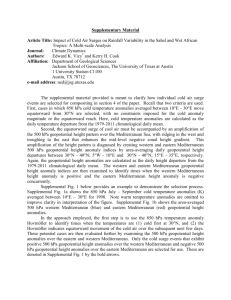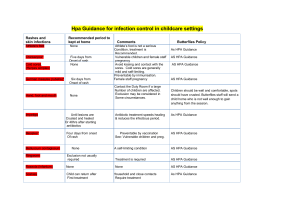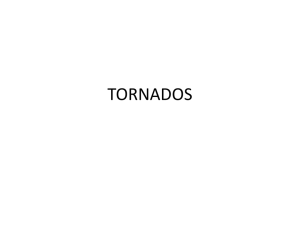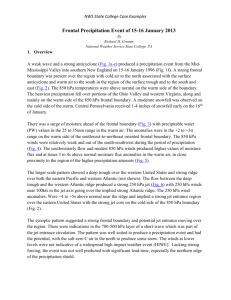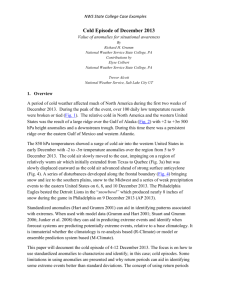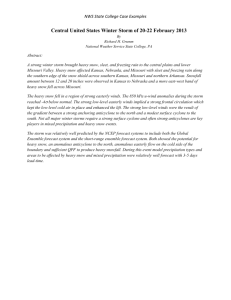09Jan2013
advertisement
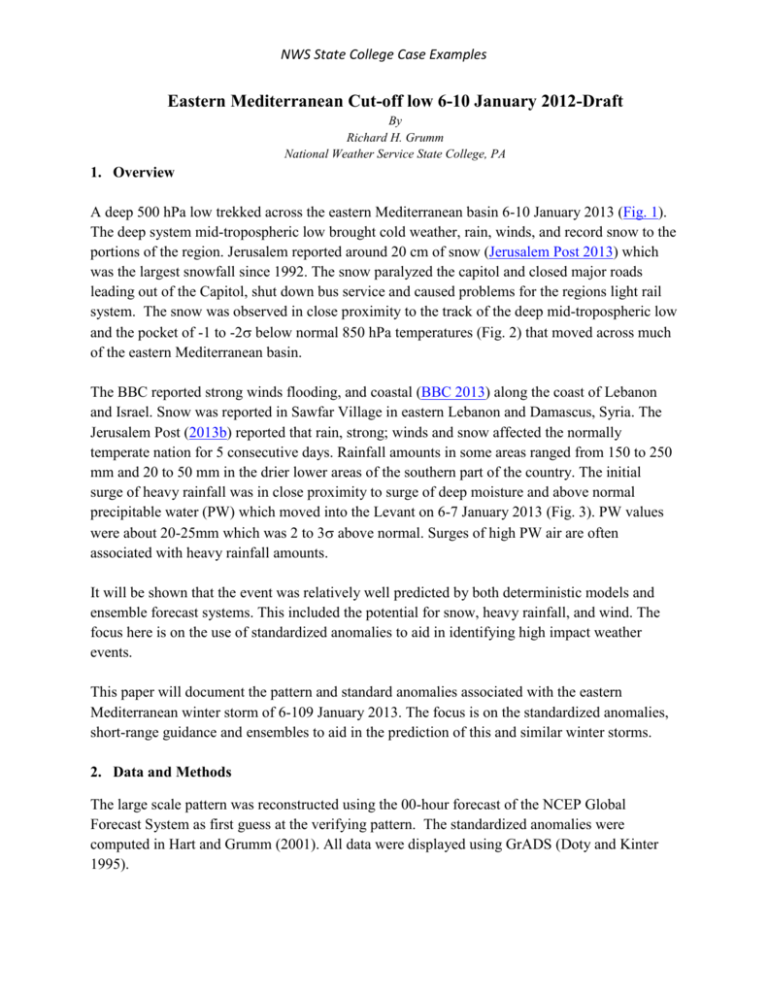
NWS State College Case Examples Eastern Mediterranean Cut-off low 6-10 January 2012-Draft By Richard H. Grumm National Weather Service State College, PA 1. Overview A deep 500 hPa low trekked across the eastern Mediterranean basin 6-10 January 2013 (Fig. 1). The deep system mid-tropospheric low brought cold weather, rain, winds, and record snow to the portions of the region. Jerusalem reported around 20 cm of snow (Jerusalem Post 2013) which was the largest snowfall since 1992. The snow paralyzed the capitol and closed major roads leading out of the Capitol, shut down bus service and caused problems for the regions light rail system. The snow was observed in close proximity to the track of the deep mid-tropospheric low and the pocket of -1 to -2 below normal 850 hPa temperatures (Fig. 2) that moved across much of the eastern Mediterranean basin. The BBC reported strong winds flooding, and coastal (BBC 2013) along the coast of Lebanon and Israel. Snow was reported in Sawfar Village in eastern Lebanon and Damascus, Syria. The Jerusalem Post (2013b) reported that rain, strong; winds and snow affected the normally temperate nation for 5 consecutive days. Rainfall amounts in some areas ranged from 150 to 250 mm and 20 to 50 mm in the drier lower areas of the southern part of the country. The initial surge of heavy rainfall was in close proximity to surge of deep moisture and above normal precipitable water (PW) which moved into the Levant on 6-7 January 2013 (Fig. 3). PW values were about 20-25mm which was 2 to 3 above normal. Surges of high PW air are often associated with heavy rainfall amounts. It will be shown that the event was relatively well predicted by both deterministic models and ensemble forecast systems. This included the potential for snow, heavy rainfall, and wind. The focus here is on the use of standardized anomalies to aid in identifying high impact weather events. This paper will document the pattern and standard anomalies associated with the eastern Mediterranean winter storm of 6-109 January 2013. The focus is on the standardized anomalies, short-range guidance and ensembles to aid in the prediction of this and similar winter storms. 2. Data and Methods The large scale pattern was reconstructed using the 00-hour forecast of the NCEP Global Forecast System as first guess at the verifying pattern. The standardized anomalies were computed in Hart and Grumm (2001). All data were displayed using GrADS (Doty and Kinter 1995). NWS State College Case Examples The precipitation was estimated using the Stage-IV precipitation data in 6-hour increments to produce estimates for various time periods. Snowfall data was collected from COOP and spotter reports. The snowfall map in Figure 4 was produced from the NWS Eastern Region collective dataset. The NCEP global ensemble forecast system (GEFS) data were used to show the larger scale forecasts. Overall, large scale models did not indicated a high probability of snow or mixed precipitation in Pennsylvania. The comparative cut-off low case of February 1992 is used as a comparison event. This event is reconstructed using the Climate Forecast System version 1 data. 3. Pattern over the region The large scale pattern over the region showed the deep 500 hPa trough over the eastern Mediterranean basin with -1 to -2s below normal 500 hPa height anomalies in the early stages of the event (Figs. 1a-c). As the system deepened the 500 hPa height anomalies fell into the -4 range (Figs. 1d-i). The 500 hPa heights bottomed out near 5340 m at 09/1200 UTC over southern Turkey, about -3 below normal height anomalies. The NCEP/NCAR re-analysis data (Fig 4) shows that 500 hPa heights over coastal Israel below 5450 m are rather rare events. During the cold and snow event of February 1992 (Fig. 5) the 5400 m contour moved into Israel along with anomalously low 850 hPa temperatures. These deep cut-off 500 hPa lows and cold systems though rare can and do occur. A deep 500 hPa trough with -4 500 hPa heights affect the region on 15 January 1973 (not shown) and the 850 hPa temperatures were -4 to -5 below normal during a cold outbreak on 19 January 1964. During the early phase of the event, there was a surge of high PW air (Fig.3) into the region. The 6-hourly data showed above normal PW values from 05/0000 UTC through 07/0600 UTC. Between 06/1200 and about 07/1800 UTC the high PW air was associated with a surge of strong 850 hPa winds (Fig. 6). The combination of above normal moisture and strong 850 hPa winds resulted in high 850 hPa moisture flux value and at times +6 above normal MFLUX anomalies over the eastern Mediterranean (Fig. 7). This event had strong winds, above normal PW, and extremely high moisture flux anomalies during the early phase, an indication of the potential for heavy rainfall. Though not shown, MFLUX anomalies remained high and peaked near +6s above normal again over coastal regions of Israel at 08/1200 and 08/1800 UTC (not shown). The second surge of high MFLUX values was observed ahead of the cold front (Fig. 8) which moved inland between 08/1200 and 08/1800 UTC. The 850 hPa temperatures were below 0C, which can often support snowfall if the boundary layer is cold enough, and the 850 hPa temperature anomalies were -1 to 2 below normal. Once the cold air had moved into the Levant with 850 hPa temperatures below 0C the potential for snow at higher elevations and away from the warm boundary layer air near the Mediterranean basin increased dramatically. NWS State College Case Examples A surface, a cyclone developed over the eastern Mediterranean. The cyclone had -2 pressure anomalies over the eastern portion of the Mediterranean basin, east of Cyprus at 06/1200 UTC (Fig. 9a), the cyclone deepened as it slowly moved eastward with pressure anomalies reaching 5s below normal as it tracked into northern Syria and into eastern Turkey (Figs. 9b-f). A second low center developed over Syria on around 08/1200 UTC (Fig. 9i). Figure 10 shows the regional geography and reference points used in the text. 4. Forecasts The surge of high PW air into the region during the heavy rain, the QPF, and the cold are the key forecast issue considered here with a focus on relatively long range forecasts. The surge of high PW into the region (Fig. 11) for the period of rainfall shows that forecasts form 6 NCEP GEFS predicted above normal PW air to imping on the coastal regions of the eastern Mediterranean on 5 January 2013. The resulting probabilities of 50 and 75 mm or more QPF during the 48 hour period from 1200 UTC 5-7 January 2013 focused heavy rain along or just offshore (Figs 12&13). The ensembles mean QPFs also indicated the potential for a significant 48 hour rainfall event (Fig. 14). The large scale 500 hPa trough (Fig. 15) and the cold intrusion, with sub-zero 850 hPa temperatures (Fig. 16) were relatively well predicted by the NCEP GEFS. Clearly, shorter range forecasts were more accurate and though not shown, there was considerable spread in longer range forecasts precluding the larger anomalies. The overall 500 hPa pattern with the deep trough, the surge of high PW air into the region, and the below normal 850 hPa temperature surges were relatively well predicted at relatively long lead-times. The key features with the heavy rainfall are shown as predicted from the NCEP GEFS on 1200 UTC 4 January 2013 (Fig. 17). The QPF is the 24 hour total for the period ending at 1200 UTC 7 January 2013 and the wind, PW, and 850 hPa moisture flux are as predicted at the mid-point of the 24 hour period. Though not shown, the MFLUX was near +6 above normal at 06/1800 UTC and 07/0000 UTC and above +4 for most of the 24 hour period of the heavy rainfall. The key features with the cold rain and snowfall on 9-10 January 2013 are shown in Figure 18. The deep 500 hPa low with -3s height anomalies is evident along with 850 hPa temperatures below 0C with -2s anomalies over most of Lebanon and Israel. The black dot shows the approximate location of Jerusalem where over 20 cm of snow fell. On the 9th there was strong 850 hPa moisture flux along the coast with 12.5 to 25 mm of predicted QPF during the period. 5. Summary A slow moving and deep 500 hPa cyclone moved over the eastern Mediterranean basin from 510 January 2013. As the low deepened the strong frontal system pulled warm moist air into the eastern Mediterranean leading to locally heavy rainfall on the 5th and 6th of January 2013. As the NWS State College Case Examples low deepened it both generated and advected cold air into the Middle East bringing with it subzero temperatures through a most of the atmospheric column. Once the cold air moved over the region, this supported snow inland and at higher elevations. Jerusalem received in excess of 20 cm of snow. The resulting multi-day event produced heavy precipitation, flooding, cold, damaging winds, and heavy snowfall. The heavier rainfall in the event occurred as a surge of high PW air and strong winds moved into the eastern Mediterranean. This produced high moisture flux and moisture flux anomalies on the order of 6s above normal. The result was heavy rainfall which was relatively well predicted by the NCEP GEFS, likely due to the strong forcing within the model atmosphere. The snow and cold phase of the event occurred when the deep 500 hPa cyclone moved into Israel, Lebanon, and Syria. Beneath this deep cold 500 hPa cyclone the 850 hPa temperatures were in the -2 to -5C range. This was sufficiently cold to allow the precipitation to fall as snow in the higher terrain and away from the warm boundary layer air from the Mediterranean to the west. The deep cyclone and cold air was relatively well predicted, with long lead-time by the NCEP GEFS. Synoptically, a deep slow moving cyclone, with a close mid-level cyclone brought a surge of strong winds and above normal moisture into the eastern Mediterranean basin. The result was a multi-day precipitation event, with locally heavy rainfall, inland and elevation dependent snowfall, and strong winds. The precipitation resulted in regional flooding and some areas of heavy snow fall. The heavy snow portion of the event involved a deep 500 hPa closed cyclone and a core of cold air at 850 hPa. This produced the largest snowfall in Jerusalem since February 1992 when a similar deep cut-off low and deep cyclone moved over the region. 6. Acknowledgements NCEP for the data and IMS for information related to the storm 7. References Doty, B.E. and J.L. Kinter III, 1995: Geophysical Data Analysis and Visualization using GrADS. Visualization Techniques in Space and Atmospheric Sciences, eds. E.P. Szuszczewicz and J.H. Bredekamp, NASA, Washington, D.C., 209-219. Miller, J.E. 1946: Cyclogenesis in the Atlantic coastal region of the United States. J. Meteor.,3,31-44. NWS State College Case Examples Figure 1. Return to text. NWS State College Case Examples Figure 2. Return to text. NWS State College Case Examples Figure 3. Return to text. NWS State College Case Examples January 500 hPa height bins -Tel Aviv 2500 2000 Count 1500 Series1 1000 500 0 5875 5870 5750 5700 5650 5600 5550 5500 5450 5400 5350 5300 height bin (m) Figure 4. NCEP/NCAR reanalysis data of 500 hPa heights over a point near Tel Aviv for the month of January from 1948-2010 Return to text.. NWS State College Case Examples Figure 5. Reanalyis data of the deep trough and cold air with the snow event of February 1992. Return to text. NWS State College Case Examples Figure 6. Return to text. NWS State College Case Examples Figure 7. Return to text. NWS State College Case Examples Figure 8. Return to text. NWS State College Case Examples Figure 9. Return to text. NWS State College Case Examples Figure 10. Reference map of the affected countries and region of the eastern Mediterranean to include terrain. NWS State College Case Examples Figure 11. Return to text. NWS State College Case Examples Figure 12. As in Figure 11 except for QPF from 6 NCEP GEFS Cycles showing the probability of 50 mm or more QPF in the 48 hours ending at 1200 UTC 7 January 2013. Return to text. NWS State College Case Examples Figure 13. As in Figure 12 except for 75 mm QPF threshold. Return to text. NWS State College Case Examples Figure 14. As in Figure 12 except for the ensemble mean QPF (mm) as in the shading bar and the each member 50 mm contour. Return text. NWS State College Case Examples Figure 15. NCEP GEFS forecasts of 500 hPa heights and 500 hPa height anomalies valid at 0000 UTC 09 January 2013 from the NCEP GEFS initialized at a) 0000 UTC 02 January, b) 0000 UTC 03 January, c) 0000 UTC 03 January, d) 0000 UTC 04 January, e) 1200 UTC 04 January, f) 0000 UTC 05 January, and f) 0000 UTC 06 January 2013. Return to text. NWS State College Case Examples Figure 16. As in Figure 15 except for 850 hPa temperatures and anomalies valid at 0000 UTC 10 January 2013. Return to text. NWS State College Case Examples Figure 17. NCEP GEFS initialized at 1200 UTC 4 January 2013 showing a) 850 hPa winds and u-wind anomalies, b) precipitable water and precipitable water anomalies, c) 850 hPa moisture flux and moisture flux anomalies, and d) the mean precipitation for the 24 hour period ending at 1200 UTC 7 January 2013. The black dot is the location of Jerusalem. Return to text. NWS State College Case Examples Figure 18. NCEP GEFS forecasts from the 1200 UTC 8 January GEFS valid at 1200 UTC 19 January 2013 showing a) 500 hPa heights and 500 hPa height anomalies, b) 850 hPa temperatures and temperature anomalies, c) 850 hPa moisture flux, and d) the 30h QPF ending at 1200 UTC 10 January 2013. The black dot is the location of Jerusalem. Return to text.
